Introduction
Saturn has intrigued human beings ever since they noticed that it belongs to the group of objects called planets, which move relative to the ”fixed stars” in the sky. Saturn is the slowest moving of the ancient planets. It takes fully 29.46 years to return to the same position in the sky. Two orbits of Saturn are thus very close to an integral number of 59 Earth years, so that the phenomena of Saturn repeat on roughly the same yearly date after an interval of 59 years. This was recognized by the ancient Babylonians and Greeks. Thus, Saturn was associated with the measurement of time being named Cronos (time) in Greek legend and serving as the father of the lord of planets Jupiter (Zeus). The Romans celebrated the winter feast Saturnalia in his honor, and the name Saturn today is fixed in our language in the word Saturday.
While all of the major planets have faint ring systems, the rings of Saturn are so bright and extensive that Saturn is undoubtedly the most spectacular telescopic object in the sky. When viewed with a good telescope, Saturn seems to float mysteriously and serenely in the vast reaches of space. When the rings of Saturn are opened to their maximum, they provide 1.3 times as much light as the ball of the planet. During ring plane crossings when the rings are edge-on to an observer on Earth and thus become invisible, the visual brightness of the Saturn system diminishes by 0.92 magnitudes. During opposition, when the Sun, Earth, and Saturn are all lined up with Saturn being on the nightside of the Earth, the ball of the planet has a diameter of 19.4 arcsec, but the major visible rings (A, B, and C) add another 24.4 arcsec to its extent, a total of 43.8 arcsec. This is about the size of Jupiter, even though that planet is bigger and much closer to us.
Viewing Saturn with his primitive telescope, Galileo, in 1610, was the first to notice that Saturn was odd. He thought that Saturn was composed of three, ”I have observed the most distant planet to be a triple one”, he wrote. Other observers thought Saturn had “handles” or ansae; a name that is still applied today to the ring system of Saturn (east or west ansae). It was not until 45 years later in 1655 that the versatile Dutch scientist Christiaan Huygens solved the problem of Saturn’s rings. Huygens also discovered Saturn’s largest and brightest satellite, Titan, a satellite so intriguing that we devote a whole section to it. Incidentally, Huygens felt that the solar system was now complete and no more objects could be discovered; because with six planets and six satellites known, a perfect number of 12 had been attained. These metaphysical arguments were soon dispelled by the discovery of four more satellites of Saturn by the Italian/ French astronomer, Jean Dominique Cassini: Iapetus (in 1671), Rhea (in 1672), and Dione and Tethys (both in 1684). In 1675, Cassini also discovered the prominent division between the A and B rings, called the Cassini division.
For the next 250 years or so, until the end of the nineteenth century, visual telescopic observation was the tool of the astronomer. Progress was slow but steady, and work was conducted on such subjects as the dynamics of the solar system and the best parameters for Saturn’s orbit, the orbits of its satellites, the dimensions and changing aspect of its rings, the mass and size of Saturn, its shape or its oblateness, its density and the search for features such as belts or zones in Saturn’s atmosphere or transient spots which allowed determin of Saturn’s rotation rate. Most of the well-known astronomers of that period contributed to our understanding of Saturn: William Herschel, Friedrich Bessel, William Bond, Johann Encke, Wilhelm Struve, William Lassell, Edward Barnard etc.
Our understanding of the Saturn system accelerated considerably at the beginning of the twentieth century as the new era of science and technology developed. Some of the technological advances that made this possible were the invention of the photographic process, the development of spectroscopy, electronic photometry, high-speed computers, and modern electronics that use large-area, high quantum efficiency detectors such as CCDs (charge-coupled devices). Advances in technology culminated in humanity’s age old dream of actually visiting the planets using spacecraft. A summary of Saturn spacecraft exploration is given in Table 1. The Pioneer spacecraft, as its name implies, was used as a pathfinder to test the space between Earth and the major planets and to investigate the environment around Saturn. This was followed by the much more complex and sophisticated spacecraft, Voyager 1 and 2, which visited both Jupiter and Saturn and went on to explore the Uranus and Neptune systems. The Voyager spacecraft helped tremendously in our understanding of Saturn and sent back hundreds of close-up pictures that were essentially unimaginable to scientists and philosophers, even a mere hundred years ago. To put this achievement into proper perspective, one must imagine what Galileo or Huygens would have exclaimed, had they had been presented with the beautiful close-up spacecraft images of Saturn’s globe, its rings, and satellites. A newer and even more sophisticated spacecraft called Cassini/Huygens is now on its way to provide us with even more information on Saturn. This is a joint venture between the U.S. National Aeronautics and Space Agency (NASA) and the European Space Agency (ESA). NASA is in charge of the Saturn orbiter Cassini, and ESA is responsible for the Huygens descent probe to Titan’s surface. Titan has been revealed as a close analog to primitive Earth, when life was just developing, and therefore it was targeted to be investigated even more intensely than its large parent Saturn.
Table 1. Spacecraft Missions to Saturn
| Name | Mass | Launch | Saturn encounter | Comments |
| Pioneer 11 | 258 kg | 05 April 1973 | 01 Sept. 1979 | Also Pioneer Saturn; first spacecraft to reach Saturn |
| Voyager 1 | 815 kg | 01 Sept. 1977 | 13 Nov. 1980 | |
| Voyager 2 | 815 kg | 20 Aug. 1977 | 27 Aug. 1981 | |
| Cassini/ | 5650 kg | 06 Oct. 1997 | July 2004 | ESA/NASA mission: |
| Huygens | Saturn orbiter and Titan probe | |||
| Huygens | 318 kg | Nov. 2004 | Descent probe into | |
| probe | Titan’s atmosphere |
Every person who has ever looked at Saturn through a telescope is fascinated by this mysterious object and intuitively wishes to study and to know more about this strange far away object. A feeling for its majesty and diversity is given by the beautiful NASA photomontage of a portion of the Saturn system in Fig. 1. The description of this strange world given by Sir William Herschel in 1805 cannot be improved upon.
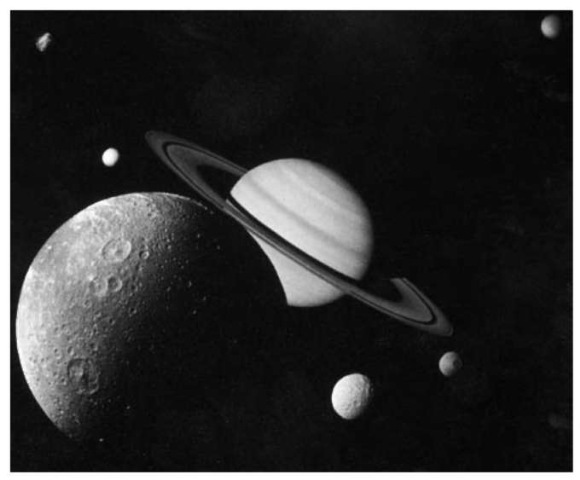
Figure 1. Photomontage of a portion of the Saturn system. The picture simulates a spacecraft flying close to the large icy satellite Dione in the foreground. Saturn and its rings are in the background. Clockwise from the upper left, the satellites visible are Enceladus, Rhea, Dione, Tethys, Mimas and cloud-covered reddish Titan in the upper right (NASA picture).
There is not perhaps another object in the heavens that presents us with such a variety of extraordinary phenomena as the planet Saturn: a magnificent globe, encompassed by a stupendous double ring: attended by seven satellites: ornamented with equatorial belts: compressed at the poles: turning upon its axis: mutually eclipsing its ring and satellites, and eclipsed by them: the most distant of the rings also turning upon its axis, and the same taking place with the farthest of the satellites: all the parts of the system of Saturn occasionally reflecting light to each other: the rings and moons illuminating the nights of the Saturnian: the globe and the satellites enlightening the dark parts of the rings: and the planet and rings throwing back the sun’s beams upon the moons, when they are deprived of them at the time of their conjunctions.
Saturn the Planet
Once Saturn was revealed in the telescope as its own world, like our Earth, it took a while to arrive at a reasonable physical model of the planet. Until about the mid-nineteenth century, astronomers subscribed to the opinion that Saturn could be inhabited by a race called Saturnians. It was deemed incredible ”that so splendid a world as Saturn should be devoid of inhabitants.” However, misgivings were also voiced, and it was noted that the physical conditions on Saturn might not make the planet suitable for inhabitants of Earth. It was realized after some time that the density of Saturn and the other major planets was considerably lower than that of Earth. The notion that Saturn might be composed of material different from Earth was at first rejected, and its low density was explained by assuming that it is a hot distended gaseous globe that had not yet cooled down and solidified. Our modern knowledge of Saturn giving some basic selected parameters is summarized in Table 2.
Bulk Composition and Interior. Physically realistic models of the overall or bulk composition of Saturn and of its interior structure were first proposed in the 1920s and 30s and were improved and revised from 1950-1989. These models were aided considerably by advances in theoretical physics such as atomic and molecular theory and quantum mechanics and by improved laboratory data and accumulating observational constraints. The first models consisted of a solid interior overlain by a relatively thin atmosphere comprising about 20% of the planet’s radius. To match the density of Saturn, it was supposed that the interior was made up of a thick layer of low-density ice that covered a small rocky core. The atmosphere was cold, and it was presumed to contain gases such as hydrogen, nitrogen, oxygen, helium, and perhaps methane whose freezing points are much lower than that of water. At the same time, it was recognized from the study of the abundance of the elements in the solar system and stars that hydrogen was by far the most abundant element. Its high abundance and low density, could possibly explain the bulk composition of the giant planets.
Table 2. Selected Parameters of Saturn
| Orbital Semimajor axis 9.539 AU (1427 x 106 km) Period of revolution around Sun 29.46 years Eccentricity of orbit 0.0557 Inclination of orbit to ecliptic 2.489° Physical Rotation period (features at the equator) 10h 14m Rotation period (magnetic field) 10h 40.5m Inclination of equator to orbit 26.73° Equatorial diameter 60,330 km Polar diameter 54,950 km Mass 95.15 me = 5.686 x 1029g Bulk density 0.70 Escape velocity 37 km/s Surface gravity 1040 cm/s2 Equator centrifugal acceleration 176 cm/s2 |
These early models overlooked two facts. The immense pressure in the interior of Saturn will increase the densities of even the lightest element such as hydrogen well above 1.0. Second, the insulating effect of Saturn’s deep atmospheric blanket retains most of the primordial energy accumulated during accretion of the planet’s mass. The interior of Saturn must therefore be quite hot. In fact, it is now known that Saturn exhibits heat flux from the interior equal to about 80% of the thermal energy it gathers from the Sun, or about 2000 ergs cm ~ 2s ~1.
To obtain the best models of the interior of Saturn, the behavior of the elements and molecules, in particular, hydrogen and helium, under the high pressures and temperatures in the interior of Saturn, must be known. The pressures encountered exceed those that can be simulated in laboratory experiments so that recourse must be taken to theoretical quantum mechanical calculations. This has led to the interesting insight that when hydrogen is put under great pressure of the order of 3 x 106 atmospheres (3 Mbar), atoms or molecules lose their individuality and a high-density fluid of protons and electrons results. This state is quite conductive and has been given the label, metallic hydrogen.
There is no agreement on a unique model of Saturn’s interior, but there is general consensus on its basic features. A typical model is shown in Fig. 2. The temperature at the 1-atmosphere (1-bar) level is about 140 K. Proceeding to the interior, the pressures and temperatures of Saturn’s atmosphere keep rising, almost like diving into a limitless ocean, until the transition to metallic hydrogen (H +) occurs about halfway into the planet at a pressure of about 3 Mbar (3 x 106 atmospheres). After the layer of metallic hydrogen gas, one possibly encounters a mantle of higher density ices, probably liquid, and a core of even higher density rock-forming elements, Si, Mg, O, and Fe. It is not certain whether the core is solid or liquid. A concentration of mass near the core is required by the higher order terms of Saturn’s measured gravitational field. The mantle and core must contain about 20% of Saturn’s mass. This makes the fraction of the elements that constitute the core and mantle considerably larger than for the solar composition for which it would be 2-3% of Saturn’s mass. Thus, it is generally believed that Saturn’s composition is not solar but is enhanced in rock-forming elements and/ or ices by about a factor of 10. This enhancement must be accounted for in scenarios of Saturn’s formation from the solar nebula.
Atmospheric Composition. Most of the direct compositional information that we have about Saturn comes from spectroscopy. Interestingly, Saturn had been observed visually with a spectroscope already in 1863 by the Italian astronomer, Father Secchi. He found dark unidentifiable absorption bands in the red part of the spectrum of the major planets. He felt that the atmospheres of these planets had not yet been “cleansed” and contained elements different from Earth’s atmosphere. These absorption bands were photographed in 1905 by E.C. Slipher of Lowell Observatory, but an identification was not made until 1932. They are caused by large amounts of gaseous methane in the atmosphere. The detection of molecular hydrogen, H2, although strongly believed present in even larger amounts, proved even more difficult. H2 does not have a regular dipole spectrum in the infrared like most molecules, but exhibits only an exceedingly weak quadrupole spectrum. Lines from this spectrum were finally identified in 1963, and it was found that the amount of H2 above the visible cloud tops of Saturn’s atmosphere is about 10 times the amount of the total Earth’s atmosphere. Further work in the 1970s and 1980s resulted in additional ground-based spectroscopic detection of the species PH3,C2H2,C2H6, and NH3.
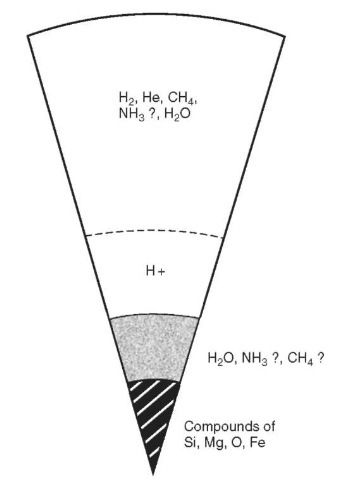
Figure 2. Model of the bulk composition and interior of Saturn after W.B. Hubbard and D.J. Stevenson. Saturn, T. Gehrels and M.S. Matthews (eds). University of Arizona Press, Tucson, 1984.
A summary of the composition of Saturn’s atmosphere is given in Table 3. The major component is H2 comprising about 92% of the atmosphere. Helium makes up most of the rest, but the exact fraction of He is difficult to determine. Its abundance cannot be measured by direct spectroscopic methods but must be inferred by its effect on other gases. It is estimated that the He abundance by number of molecules (He/H2) is about 6-10%. This number is quite uncertain, however, and needs further investigation and confirmation. If correct, it makes He about half as abundant as the 13% measured for the Sun.
Table 3. Observed Composition of Saturn’s Atmosphere
| Species | Abundance | Comments |
| H2 | b92% | Major atmospheric constituent |
| He | Inferred from secondary effects | |
| H2O | ? | Presumed present but not detectable above 1 atm |
| CH4 | 0.2% | Enhanced by 2 to 3 over solar |
| NH3 | 0.03% | Frozen out above 1 atm |
| PH3 | 2ppm | Enhanced by about 3 over solar |
| C2H6 | 5.0 ppm | Abundance for upper atmosphere only where |
| C2H2 | b0.09 ppm | these molecules are produced by |
| photodissociation |
It might be thought that the abundance of molecules is easier to determine for the extensive atmosphere of Saturn than for the modest atmosphere of its companion, Titan, but this is not the case. The level of the atmosphere probed depends on the wavelength of light. This makes it difficult to calculate the mixing ratios of gases detected in different spectral regions. In the deep atmosphere of Saturn, the most abundant molecule, after He, is thought to be water, but it has not been found because it is frozen out below altitudes to which spectroscopically detectable light reaches. Ammonia also freezes out but higher in the atmosphere, and so it has been observed. Its ratio varies with altitude and the exact level at which its presence has been detected is not certain. The abundance of methane is affected by the scattering properties of Saturn’s atmosphere and is thus also not easily defined precisely. The best present determinations of the mixing ratios in Table 3 indicate that the species CH4,NH3 and PH3 are enhanced about a factor of 2 to 3 over their abundance expected from solar composition. This lends observed compositional support to models of the interior of Saturn which point to a substantial enhancement of ice and rock-forming elements.
The variety and complexity of the molecules detected in Saturn cannot rival those of the atmosphere of Titan. The same Voyager infrared instrument that detected so many molecules in Titan could confirm only ethane (C2H6)and acetylene (C2H4) for Saturn. As explained in the section on Titan, the reason for this lies in the number of permissible photochemical reactions, which are considerably more limited under conditions of high H2 abundance. The abundance of C2H6 and C2H4 given in Table 3 are for the stratosphere of Saturn. Their abundance drops by a factor of 106 for the deep well-mixed Saturn atmosphere.
Visual Appearance and Colors. Early eighteenth and nineteenth century telescopic observers of Saturn focused much of their attention on the visual appearance of the planet. Investigators looked for the banded structure that is so prominent on Jupiter and tried to discover atmospheric features from which Saturn’s rotation period could be determined. Yet, Saturn’s cloud structure is considerably different from that of Jupiter. While it shows some bands and zones, this structure on Saturn is very much muted and hard to see. The picture of Saturn in Fig. 3 is considerably enhanced and shows the structure typically displayed by Saturn. A faint slightly darker and yellowish band called the equatorial belt at latitudes of about 15° North or South can be seen and was described by many observers. It marks the limit of the bright equatorial zone. Sometimes another dark band, or possibly two, is seen at higher latitudes of about 30°. The polar regions above latitudes of ~60° are darker. The variable appearance of these features has been followed by observers from Cassini and Herschel to the modern Voyager spacecraft images.
Saturn is not round, but it exhibits considerable oblateness, the largest of any planet in our solar system. The equatorial radius is about 10% larger than the polar radius. This is caused by Saturn’s rapid rotation. The centrifugal acceleration at the equator is 176 cm sec ~ 2, which is roughly 17% of its gravitational attraction. The resulting attractive force at the equator is thus considerably less than at the poles allowing the material at the equator to spread to a much larger radius.
One would very much like to have an explanation for the different colors of the zones and belts that have been admired by observers during the last few hundred years. Yet this has been achieved neither for Jupiter nor for Saturn. The subdued tones, it is believed, are caused by coloring agents or chromophores that are present in such minute amounts that they have not yet been identified. The suggestion has been made that the colors are caused by dilute allotropes of sulfur or phosphorous which can have a yellow or red or even black appearance.
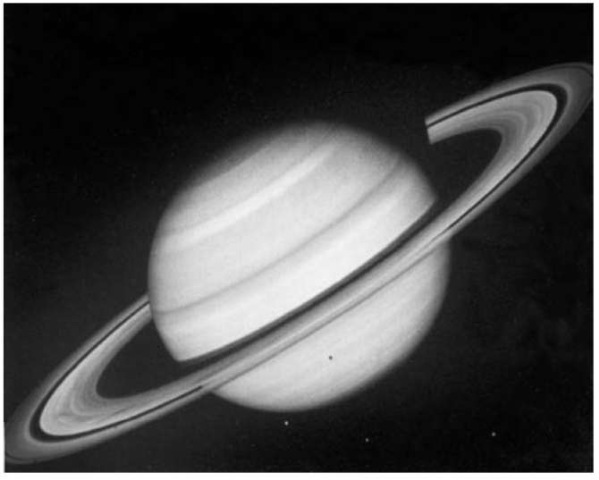
Figure 3. Image of Saturn and its rings floating mysteriously in space taken by the Voyager 2 spacecraft. The sun comes from below so that the ball of Saturn casts a shadow on the rings, and the inner Crepe Ring in turn forms a shadow on Saturn. Also visible are three icy satellites Tethys, Dione and Rhea in the foreground. The shadow of the leftmost satellite Tethys is projected onto the atmospheric cloud deck of Saturn (NASA picture).
Triclinic solid phosphorous (P4) is red, and allotropes of phosphorous are likely because PH3 has been detected and can be photodissociated high in the atmosphere. Sulfur-bearing molecules such as H2SorNH4HS are frozen out lower in Saturn’s atmosphere and are less likely to be convected to great heights. Atmospheric Structure, Clouds. A temperature profile for the observable part of Saturn’s atmosphere is given in Fig. 4. The temperature profile in Fig. 4 is determined from radio occultation and infrared experiments onboard Voyager. The minimum temperature of about 85 K occurs at the tropopause at a pressure of about 0.10 atm. (This is similar to that level on Earth.) Above that level, in the stratosphere, the temperature rises slightly before becoming isothermal. Below that level, the temperature increases at a rate of about 0.9K/km. This rate is called the adiabatic lapse rate, and it is expected if the atmosphere is strongly convective. At a level of about 1 atm, which is roughly the limit of our remote sensing observability of Saturn, the temperature has risen to 140 K. Near this level, the cloud density becomes so thick (optical depths 3-5), that even long-wave infrared radiation cannot penetrate below. It is presumed that this cloud deck is made of ammonia crystals, and there is some evidence for solid NH3 absorption in infrared spectra, but this is not definite. The temperature at the 1-atmosphere level is still too cold to allow an appreciable amount of gaseous NH3 to exist in the troposphere.
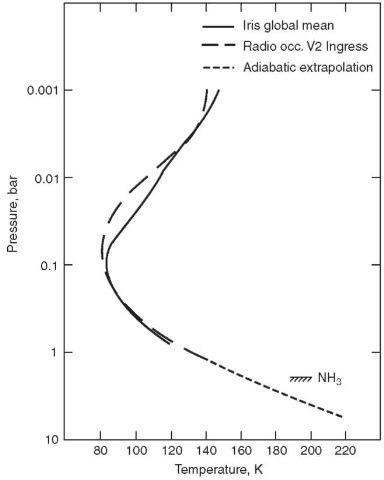
Figure 4. Temperature profile of the atmosphere of Saturn that is accessible to remote sensing. The temperature profiles are from measurements by the Infrared Imaging Spectrometer (IRIS) on the Voyager spacecrafts, the Voyager Radio occultation measurements, and an adiabatic lapse rate model for the deeper atmosphere. Graph is from A.P. Ingersoll et al. Saturn, T. Gehrels and M.S. Matthews (eds).
The atmosphere above the thick cloud deck is not clear but contains a haze of NH3 crystals extending to the tropopause. This region contains different dilute concentrations of chromophores that create the different colors among the belts and the zones. It is known that the zones are regions of atmospheric upwelling while the duskier belts are regions where cold stratospheric air descends. The colder troposphere of Saturn, compared to that of Jupiter probably results in a paucity of upwelling chromophoric parent molecules, such as PH3, leading to a lower concentration of coloring agents and a subdued contrast between the belts and zones.
Rotation Rate and Circulation. The determination of Saturn’s rotation rate by using visible atmospheric features was quite difficult, compared to Jupiter, because well-defined features in Saturn’s atmosphere are rare. William Herschel in 1794 was the first to measure a rotation rate, and his value of 10h16m is close to the present value of 10h14m for features near the equator. After Herschel, well-defined spots on Saturn were not observed until 1876, and this was followed by a series of spots observed from 1891-1903. It was realized that Saturn has a very pronounced differential rotation rate; spots at latitudes ~35°N traverse Saturn considerably more slowly in a time of about 10h38m. The most accurate rotation rate today comes from measurements of the rotation of Saturn’s magnetic field which is 10h40.5m. It is felt that this represents the rotation period deep inside Saturn’s conductive metallic hydrogen mantle.
The rotation rate of surface spots can be used to measure the upper atmospheric currents or the weather on Saturn. It is found that the wind speeds in Saturn’s upper equatorial zone are about 500 ms ~1, which is 1100 miles/hour! The same phenomenon is found on Jupiter, but that planet’s equatorial wind speed is about 120 ms ~1, while jet streams on Earth have typical speeds of perhaps 100 miles/hour. Besides having an equatorial wind speed four times higher, Saturn’s equatorial zone is also about twice the width of Jupiter’s. It is not yet clear what causes the large difference between the planets. It could be attributed to a combination of Saturn’s lower surface gravity and its lower internal heat flux. Another interesting question, not presently answered, is the depth of the zones of differential rotation. It is conjectured that they may persist to 10,000 km or more into the interior of the planet. The ”weather pattern” on Saturn may thus be of an entirely different nature from that observed on Earth.
The Rings of Saturn
Galileo was the first to describe the Saturn system, but he was confused by its appearance and could not come up with a correct explanation. The correct interpretation for the rings of Saturn and their changing appearance was first given by Christiaan Huygens in 1655: “Annulo cirgitur tenui, piano nusquam cohaerente…” ”a thin ring surrounding Saturn nowhere touching the planet”. His discovery of Saturn’s satellite, Titan, and its 16-day orbit around Saturn helped him realize that the line of ansae (i.e., the ring plane) was tilted about 27° with respect to Saturn’s orbital plane. With the ring plane fixed in space, to a viewer on Earth, the rings would change from perfectly edge-on to completely open, as Saturn travels around its orbit. This resolved Galileo’s mystery when 2 years after he viewed the rings, they mysteriously disappeared leaving him baffled and confounded.
When viewed through the telescope, the rings appear to the eye as a solid sheet separated by the Cassini division. Early investigators thus believed the rings to be made of two solid annuli. But how were these annuli held in place around Saturn and did they have a rotational period? Their uniform appearance foiled every realistic attempt to determine a rotational period. The French mathematician Laplace presented calculations in 1785 which showed that the rings must be made of many individual narrow rings and that the rings must rotate about the planet in Keplerian orbits, that is, each narrow ring must circle the planet with a rotation period given by Kepler’s third law. This theory was expanded in 1857, by James Clerk Maxwell who showed that the rings must be made of individual particles or satellites. These objects were so densely packed that to the eye they gave the appearance of a solid continuous sheet. The fact that the rings rotate at their respective Keplerian velocities was proven in 1895 by the American astronomer James E. Keeler using the new science of spectroscopy. As the ring particles rotate about Saturn, those on one side are coming toward us, whereas those on the other side are moving away from us. By the Doppler principle, this produces a wavelength shift to the blue and to the red, respectively. The velocities of the particles on the outside edge of the ring are slower than those on the inside edge, resulting in tilted spectral lines. This Doppler shift tilt was large enough that it could be captured on the photographic plates of that time, giving observational proof of the rotation of the rings and their composition of individual particles.
The major ring system, its size, and nomenclature are given in Table 4. The reason for the somewhat confusing sequence of names is historical. The two bright rings that can most easily be seen in the telescope are called A and B (starting with the ring farthest from Saturn). The A and B rings are separated by the Cassini division discovered by the Italian/French astronomer, Jean Dominique Cassini, in 1675. A fainter ring, called the C ring or Crepe ring, inside ring B was first described by the American astronomer, W.C. Bond (1850). Inside the C ring, astronomers using ground-based telescopes thought they saw another faint ring called D. This ring could not be detected by the Pioneer 11 spacecraft. However, the Voyager spacecraft did find an exceedingly faint ring system near that position. Even though the ring was so faint that it could not have been detected from the ground, its assignment as D ring was kept. A faint diffuse ring outside of the A ring was discerned using ground-based telescopes in 1967 and was called the E ring. It was verified by the Voyager spacecraft. The detection of a very narrow ring 50 km wide outside the A ring, which was called the F ring, was one of the interesting discoveries by the Pioneer 11 spacecraft. The Voyager spacecraft also imaged a very diffuse ring between the F and E ring which was labeled G. It was first detected indirectly by the Pioneer 11 spacecraft because of its influence on charged particles.
Table 4. The Rings of Saturn: Nomenclature, Size, Features
| Distance from Saturn center | Features | ||
| km | |||
| Saturn boundary | 60,330 | 1.00 | Top of visible atmosphere; |
| equatorial radius | |||
| D ring | 67,000-73,200 | 1.11-1.21 | Quite tenuous, discovered by |
| Voyager | |||
| C ring | 74,500-92,200 | 1.23-1.53 | Crepe ring, Bond(1850) |
| B Ring | 92,200-117,500 | 1.53-1.95 | Biggest and most extensive |
| ring; easily seen with | |||
| telescope | |||
| Cassini division | 119,000 | 1.97 | Discovered by Cassini in 1675 |
| (middle) | |||
| A ring | 121,000-136,200 | 2.03-2.27 | Outermost ring seen with |
| telescope | |||
| Encke gap (middle) | 133,600 | 2.21 | Discovered by Encke; quite |
| sharp, b 328 km wide | |||
| F ring (middle) | 140,400 | 2.33 | Discovered by Pioneer; quite |
| narrow, ~50km | |||
| G ring (middle) | 170,000 | 2.82 | Discovered by Pioneer |
| E ring | 181,000-483,000 | 3-8 | |
The illusory telescopic view of the rings as a solid sheet has already been discussed. During the centuries, many different divisions were spotted and described by observers, but except for the obvious Cassini division and the fleeting Encke gap, no consensus by any observers could be established. Not many people, however, were prepared for the astonishing images sent back by Voyager which showed thousands of individual ringlets. A sample image is provided in Fig. 5. Even Voyager’s best resolution of about 10 km could not reveal the wealth of detail present. A stellar occultation with the Voyager photopolarimeter instrument indicated that there must be tens of thousands of ringlets. Additionally, quite unsuspected anomalous features such as several noncircular ringlets that have notable eccentricities and several “braided” ringlets were observed.
A very puzzling transient phenomenon of radial spokes in the B ring was observed by Voyager. Those can be seen quite clearly in Fig. 5. The spokes generally rotate around Saturn with the Keplerian velocities of the particles and thus lent themselves to several Voyager imaging time sequences that were assembled into a captivating movie. Most likely, the spokes are made of micron-sized particles slightly above the plane of the rings, whose light scattering properties makes them visible, and their formation is connected with Saturn’s magnetic field.
Despite the very large planar extent of the rings, about 61,700 km for the A, B, and C rings, the rings are quite thin. Ground-based observations during Saturn’s ring plane crossing yielded an upper limit of about 2 km. Voyager could not measure the exact thickness but determined an improved upper limit of 100-200 m. To get a feeling for the extreme thinness of the ring, one should realize that this is equivalent to an annular sheet of paper that has an outer radius of 400 feet and an inner radius of 220 feet! The rings of Saturn are therefore considerably less than paperthin. The features of the rings that we would like to know about are the thickness of the rings, the cause for the ring divisions, the compositions of the rings, the particle size distribution of the rings, and the total amount of material in the rings. These subjects are discussed in turn later, and though we have many partial answers, more investigation is required.
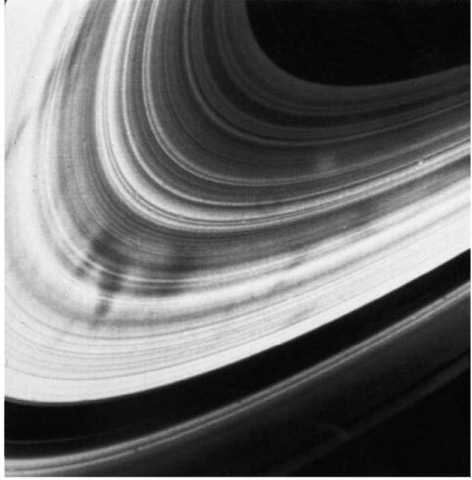
Figure 5. Close-up Voyager 2 picture of Saturn’s rings showing its structure as a multitude of ringlets and the mysterious dark radial features or ‘spokes’ (NASA picture).
A very interesting additional phenomenon found by Voyager spacecraft was the dynamic nature of the rings. Sequences of images showed that the ringlet structure is not fixed but appears to change from orbit to orbit. These small rearrangements, like waves on an ocean, occur even though the ring system as a whole is stable for millions and probably billions of years. There is no complete explanation for the ordering and arrangement of the ringlets. Density waves appear to account for many features, particularly in the A ring. Gravitational interactions with Saturn’s satellites, called resonances, account for more of the features seen. However, the resonances do not offer a ready explanation for many of the prominent major gaps, even the Cassini division. The mystery of the presence of the Encke gap was solved in 1991 by going back through the large Voyager data archive and discovering Saturn’s eighteenth satellite, Pan, in this gap. Perhaps, many of the other minor ring divisions are kept clear by smaller yet still substantially sized objects several km in diameter.
The narrow F ring has a straightforward explanation. Voyager found two satellites, one on the inner side of the F ring (S16) and one on the outer side of the F ring (S15). Like sheep dogs herding a flock of sheep, these two satellites keep the material from spreading, and therefore they are called ”shepherding satellites.”
Despite the sophistication of the Voyager spacecraft and its close approach to Saturn, its instruments could not determine the composition of Saturn’s rings. This was first done in 1970, from ground-based infrared spectra. It was found that the particles in Saturn’s rings were predominantly water ice. It is believed that some of the ice may have a core of silicate dust or that pure silicate dust particles are also present. This is particularly so for the C ring which is considerably darker than the A or B ring. The temperature of Saturn’s rings, as measured by their infrared emission, is around 90 K, which is cold enough that no significant amount of water molecules evaporate during a span of a billion years.
The size of the particles in Saturn’s rings must clearly be less than the upper bound of its thickness. The size range of the particles is estimated from the scattering properties of the rings at wavelengths from the visible to the microwave region. Particularly helpful were radio occultations by the rings of the 3.6-cm (X-band) and 13-cm (S-band) radio transmitters on Voyager. Combining these data leads to the conclusion that the particle sizes range from micron-sized grains to meter-sized boulders, and the upper limit is of the order of 10 m in diameter. The particle size distribution (cumulative number of particles versus size) appears to fall off with particle radius a as a ~ 3.
The total mass of Saturn’s rings is also a quantity that must be estimated by indirect means. Pioneer 11 passed within 4000 km of the A ring but experienced no gravitational perturbation by the ring. This gives an upper limit of 1.7 x 10 ~ 6 Ms. A variety of indirect measurements converges on a mass of about 5 x 10 ~ 8 Ms, or 2.8 x 1022g. This is about 1/2600 the mass of Earth’s Moon, or assuming a density of 1.0, is equivalent to a spherical satellite of 380 km in diameter, about the size of Mimas.
Satellites of Saturn
Presently, 30 satellites that circle Saturn are known. This gives Saturn the largest number of satellites in our solar system. Following Huygens’ discovery of Titan in 1655, four more satellites were soon found by Cassini: Iapetus (1671), Rhea (1672), and Dione and Tethys (1684). Since that time, the number of Saturn’s satellites has steadily increased. By 1900, nine satellites were known (S1-S9), and these are often called the nine classical satellites of Saturn. Preparations for the Voyager spacecraft spurred renewed interest in searching for Saturn companions, so that during the two ring plane crossing periods, 1966 and 1980, five more satellites (S10, S11, S12, S13 and S14) were discovered using Earth-based telescopes. These discoveries were aided considerably by the invention and introduction of large-area silicon array detectors called CCDs (charge-coupled devices). The Voyager spacecraft itself found an additional four satellites (S15, S16, S17, and S18) so that the number of known satellites rose to 18. More recently, astronomers from Cornell University obtained a number of deep CCD images of the surroundings of Saturn and found 12 more satellites that have been given the temporary designation S/2000 S1 to S/2000 S12 for the year of their first observation, 2000. As an aside, we note that this is much greater than the number of six to eight satellites, which Kepler (1571-1630) conjectured would be found around Saturn. It is unlikely that any sizable satellite of the order of hundreds of km diameter remains undiscovered, but it is quite likely that there are more 10-km sized objects. A list of Saturn’s satellites and some of their basic parameters are provided in Table 5. In this section, we discuss the properties of all of the satellites except Titan, which is so unusual that it deserves a special section.
As for the names of the satellites, we note that it was John Herschel, the son of Sir William Herschel, the discoverer of Uranus, who bestowed the present names on the Saturnian satellites. Following the Greek legend of Saturn, they are named after Titans or giants, either brother or sister siblings of Saturn. Before Herschel, Titan was generally known as the ”Huygenian satellite,” and Cassini tried to name the four satellites he discovered after his sovereign Louis XIV. The satellites also have numbers (S1-S18) where the S stands for Saturn. The first nine are neatly ordered by increasing distance from Saturn. Thereafter, their sequence follows the order of their discovery to avoid constant renumbering when new ones are found.
Astronomers in the nineteenth century concentrated on understanding the celestial mechanics of the satellite system by getting good positional measurements from which accurate orbital parameters could be derived. They found that the mechanics of Saturn’s satellite system was more intricate and complex than might be expected. John Herschel was the first to note that, the time of revolution of Mimas is very close to half that of Tethys, and that of Enceladus approximates half that of Dione.” Since that time, these so-called commensur-abilities or resonances have been studied intensely with increasing sophistication by investigators in celestial mechanics. If we use the following abbreviations for the mean daily motion of a satellite going around Saturn in deg/day: Mimas-Mi, Enceladus-En, Tethys-Th, Dione-Di, Titan-Ti and Hyperion-Hy, the relationships below can be written:
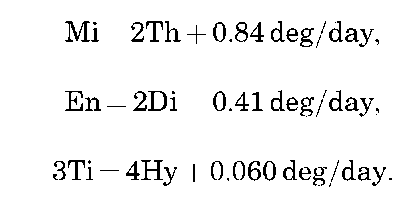
Thus, for example, an exact orbital 2:1 resonance between the orbital period of Enceladus and Dione is off by only one orbit out of 640. More sophisticated orbital mechanics can explain this small difference by the slow precession of the nodes (the line of intersection of the plane of the satellite orbit with the plane of Saturn’s orbit).
Jumping ahead for a moment to modern investigations, the Pioneer encounter, the Voyager spacecraft images, and supporting ground-based observations revealed even more surprises in the mechanics of the Saturn satellite system. Two of the satellites, Janus (S10) and Epimetheus (S11), actually share the same orbit. It was found that the satellites slowly drift toward each other in the bit, yet a collision is avoided because their mutual gravitational interaction, shifts their orbits slightly, when they get close to each other, and they drift apart again to meet on the other side of the orbit, whence the whole sequence repeats. The large satellite, Tethys, was also found, to have two coorbital objects, Telesto (S13) and Calypso (S14). These, however, remain a constant distance from Tethys since they are located at the stable Lagrangian points 60° ahead and 60° following Tethys. Dione, it was also found, has a satellite, Helene (S12), at its leading Lagrangian point. A careful search by Voyager at the following Lagrangian point of Dione failed to show any object.
Table 5. Satellites of Saturn
| Name | Dist. from Saturn, Rs | Orbital period, hrs | Size, km | Density, g/cm3 | Comments | |
| S18 | Pan | 2.21 | 13.8 | 20 | — | In Encke’s gap |
| S17 | Atlas | 2.28 | 14.4 | 40 x ? x 20 | — | A-ring shepherd |
| S16 | Prometheus | 2.31 | 14.7 | 140 x 100 x 74 | — | F-ring inside shepherd |
| S15 | Pandora | 2.35 | 15.1 | 110 x 90 x 66 | — | F-ring outside shepherd |
| S10 | Janus | 2.51 | 16.7 | 220 x 190 x 160 | — | Co-orbiting and |
| Sll | Epimetheus | 2.51 | 16.7 | 140 x 115 x 100 | — | Oscillating satellites |
| SI | Mimas | 3.08 | 22.6 | 394 | 1.4 | Densely cratered; Herschel 125 km diam. |
| S2 | Enceladus | 3.95 | 32.9 | 502 | 1.2 | Large smooth lightly cratered surface |
| S3 | Tethys | 4.88 | 45.3 | 1060 | 1.2 | Densely cratered; Odysseus 400 km diam. |
| S13 | Telesto | 4.88 | 45.3 | 30 x 20 x 16 | — | Tethys leading Lagrangian satellite |
| S14 | Calypso | 4.88 | 45.3 | 24 x 22 x 22 | — | Tethys trailing Lagrangian satellite |
| S4 | Dione | 6.26 | 65.7 | 1120 | 1.4 | Large surface brightness variations |
| S12 | Helene | 6.26 | 65.7 | 34 x 32 x 30 | — | Dione leading Lagrangian satellite |
| S5 | Rhea | 8.74 | 108 | 1530 | 1.2 | Moderately cratered; (2 populations?) |
| S6 | Titan | 20.3 | 383 | 5150 | 1.88 | Extensive atmosphere |
| S7 | Hyperion | 24.6 | 511 | 410 x 260 x 220 | — | Irregular shape |
| S8 | Iapetus | 59.0 | 1904 | 1440 | 1.2 | Large albedo difference in E, W faces |
| S9 | Phoebe | 215 | 13211 | 220 | — | Retrograde orbit; dark surface; captured? |
| S/2000 | — | — | — | — | — | Twelve additional satellites discovered |
| S1-S12 | using ground based CCD observations; no permanent name assignments yet; sparse physical information |
Four satellites (S15-S18) all have strong connections with and influence on Saturn’s ring system. The Voyager spacecraft found that the narrow F ring was restrained from spreading by two shepherding satellites, one on the outside of the ring, Pandora (S15), and one just inside the ring, Prometheus (S16). A small satellite, Atlas (S17), was found just outside the A ring and, it is believed, keeps this ring from spreading outward, thus accounting for its sharp boundary. Finally, careful inspection of the 30,000 Voyager images of Saturn and its rings in 1991 revealed an additional small satellite, Pan (S18), in the Encke gap. The satellite keeps this gap clear and provides a reason for Encke’s gap at this particular location in the rings.
Limited to the naked eye, classical telescope observers found it difficult to determine physical properties of the satellites, because even with reasonably sized telescopes, the satellites appeared as mere faint points of light. It was realized, since it was discovered by Cassini, that Iapetus is much brighter on the western side of Saturn (its trailing side as it orbits Saturn) compared to the eastern side. As Cassini stated, ”This satellite disappears regularly for about one-half of its revolution when it is to the east of Saturn.” Modern photoelectric measurements have determined that this variation is 1.7 magnitudes, or a factor of 4.8! This light curve, invariable for centuries, is considered proof that Iapetus keeps the same face toward Saturn as it orbits that planet, just as our moon shows the same face to Earth. Iapetus’ rotational period is synchronously locked with its rotational period around Saturn.
Variations in visual orbital brightness were sought for the other satellites but yielded conflicting results. In the 1970s ground-based electronic photometry revealed that the satellites Rhea, Dione, and Tethys differ from Iapetus and are all brighter on the leading side, respectively, by 0.20, 0.40 and 0.20 magnitudes. On the other hand, Mimas is brighter on the trailing side by about 0.2 magnitudes. Most of Saturn’s satellites for which rotation periods have been determined, namely S1, S2, S3, S4, S5, S8, S10, and S11, are synchronously locked to Saturn. The rotation period of the outermost satellite, Phoebe, is 9.4 hours, and Hyperion does not have a stable rotation period but tumbles chaotically.
Attempts were made to determine satellite sizes during periods of superior seeing, and sizes were estimated from their brightness by assuming a reasonable reflectivity. The theory of orbital resonance, discussed earlier, allowed determining the masses of some satellites. Combining the mass and size made estimates of the satellites’ densities possible. This led to the interesting realization in the 1920s that satellite densities were probably best described by a value airly close to one which is similar to the density of water ice. This density is considerably different from that of rocky material whose values are 2.5-3.0. The icy composition of Saturn’s satellites has been borne out by modern measurements. The best present densities that combine data from the Voyager spacecraft and ground-based observations are given in Table 5. The listed densities are all slightly higher than 1.0, but it must be remembered that the density of ice increases as pressure increases in the interior of the satellites and somerocky material is probably mixed with the ice, both on the surface and in the interior.
Electronic photometry in the twentieth century was used to determine accurate values for the brightness, or visual magnitude, of the satellites, as well as their broadband colors in the violet, blue, visible, and red. These measurements showed that the surface reflectivity, or albedo, of the satellites was quite high, typically of the order of 50-60%. The highest value measured was 90% for Enceladus. A material on Earth that has this high reflectivity would be brilliantly and blindingly white. Improved measurements in the thermal emission regime showed that the surface temperatures were quite low, of the order of 90 K, even in the warmest regions near the equator. Probably the most significant ground-based results were provided by infrared spectroscopy of Iapetus, Rhea, Dione, and Tethys in 1976. These data unmistakably showed the unique signature of water ice. Combining this direct proof of the existence of water ice with the low density of the satellites and their low surface temperatures leads to the conclusion that the large spherical satellites of Saturn are composed of water ice. They are thus labeled Saturn’s icy satellites.
To make further progress in our understanding of the satellites, close-up views were needed and these became available the beginning of the Space Age. Following the exploratory Pioneer missions, the two Voyager spacecraft imaged all fourteen satellites known at that time, plus four additional ones that were discovered.
Having roughly the same density and being of comparable size, it might be expected that the satellites all had a similar origin and thus closely similar appearances, but this was not found to be the case. Each satellite turned out to have its unique individual characteristics, making them distinctly different from each other. The six major icy satellites, Mimas, Enceladus, Tethys, Dione, Rhea, and Iapetus, are shown together with the much smaller bodies, Hyperion and Phoebe, in Fig. 6. All of them have sufficient self-gravity to make them spherical, and all of them possess cratered surfaces to various degrees. At the low surface temperatures of these satellites, water ice is as rigid as ordinary rock and can easily retain a cratering history of a billion years or so. Curiously enough, and perhaps not by accident, the six large icy satellites of Saturn show a gradation in size as one moves outward from Saturn; Mimas and Enceladus are about 450 km, Tethys and Dione about 1100 km, and Rhea and Iapetus about 1500 km in diameter. Although the satellites in Fig. 6 may look similar to our Moon, we tend to forget that these are icy bodies that have high reflectivities and would be brilliantly white if one could stand on their surface; our Moon has a very low albedo of 0.06 and is quite dark.

Figure 6. Composite of the icy satellites of Saturn. Roughly 450 km diameter satellites Mimas and Enceladus are at the top left, then come the roughly 1100-km diameter satellites Tethys and Dione. The bottom row shows the two larger 1500-km diameter satellites Rhea and Iapetus, as well as the two much smaller and irregularly shaped objects Hyperion (about 300 km) and Phoebe (about 220 km). Ground-based observations have established the presence of water ice on the surfaces of all of these objects except Phoebe. The brightness of Phoebe has been enhanced considerably; it is actually a very dark object whose reflectivity is close to that of the dark side of Iapetus (NASA composite).
Mimas. This innermost satellite of the large icy satellites is quite heavily cratered, and its surface shows little evidence of interior activity. Its appearance is dominated by one large crater, “Herschel,” on its leading surface. The crater is 130 km in diameter and thus covers about one-third of the satellite’s diameter.
Enceladus. This satellite is almost the same size as Mimas, but it has considerably different surface features. There are sizable areas on this satellite that are moderately cratered (though not as densely as Mimas); its most noteworthy features are large uncratered smooth plains. These plains are traversed by very noticeable ridges and grooves. It appears that large areas of this satellite were flooded by liquid water from the interior, which formed the smooth plains and obliterated any previous cratering history. The extensive icy plains of this satellite give it very high reflectivity. It is not yet clear what made this satellite so different in appearance and geologic history from its twin, Mimas. Tethys. This satellite is densely cratered across its whole surface, similar to Mimas. It presents almost no evidence of geologic surface activity. Interestingly enough, similar to Mimas, Tethys has one very large 400-km diameter impact crater “Odysseus.” Although the extent of this crater is 40% of the satellite’s diameter, it does not dominate the surface as Herschel does for Mimas, because Odysseus has lost its sharp boundaries and deep interior and has “relaxed” considerably. An additional feature of Tethys is a 2000-km long valley called Ihaca Chasma, that stretches three-quarters of the way around its circumference.
Dione. Dione has the highest density of any of the icy satellites and thus probably the highest component of rocky material. This is corroborated by its relatively low albedo and the weaker signature of water ice on its surface. Its overall crater density is relatively low, and there is no significant difference in crater density between the leading and trailing sides. There is, however, a distinct difference in visual appearance between these two sides. The trailing hemisphere is darker by 0.4 magnitudes (a factor of 1.5) and shows strong albedo markings of global dark terrain traversed by half a dozen broad white bands, some extending across the whole diameter. These white bands have a reflectivity of 0.7 versus the general background reflectivity of the dark material of 0.2. It is likely that the bright bands were created by a global system of faults that allowed fresh clear ice to cover the surface. Dione has several terrains that have different crater densities and a considerable level of geologic activity and resurfacing.
Rhea. Rhea is the largest of the icy satellites. Similar to Dione, it has a trailing hemisphere that is darker, though only by 0.2 magnitudes (a factor of 1.2), and like Dione, it has several bright bands extending across the otherwise darker trailing hemisphere. Rhea is fairly heavily cratered, and there appears to be no difference in cratering activity between the leading and trailing side. There are indications that it is an older terrain that retained craters larger than 30 km in diameter and a younger resurfaced terrain, but there is no consensus on this point.
Iapetus. The huge albedo difference between Iapetus’ leading and trailing sides has already been mentioned; the leading side has a reflectivity of 4%, as dark as coal dust, whereas the leading side is quite bright and has a reflectivity of 30-40%. It might be thought that a few good images of the satellite would have resolved this question, but this was not the case. The Voyager spacecraft did not get close enough to Iapetus for good high-resolution pictures, and the dark areas were so dark that the cameras could not pick up any detail! The bright side of Iapetus is quite heavily cratered. Because its density is 1.1, Iapetus clearly must be composed of water ice. Thus, the reason for the bright and dark hemispheres of Iapetus still remains a mystery.
Other Satellites. The two other moderate sized satellites, Hyperion and Phoebe, are quite different from each other. Spectroscopy indicates that Hyperion belongs to the class of icy satellites. Its size of 300 km argues for a spherical shape, yet it is quite irregular and probably is a leftover fragment of a past collision. Phoebe on the other hand, although slightly smaller, appears to be spherical. It is in a retrograde orbit that makes it an irregular satellites, and it has a dark surface and a visual reflectivity that is better matched by rocks.
A composite picture of the small irregular shaped satellites is shown in Fig. 7. The exceedingly interesting dynamic properties of S10-S18 have already been discussed. The Encke gap satellite S18 shows up only as a bright dot in the Voyager images and so allowed no shape inferences. The Voyager imaging was good enough that the remaining small satellites (S10-S17) all showed distinct irregular shapes. They appear to be fragments of collisions, very likely captured.
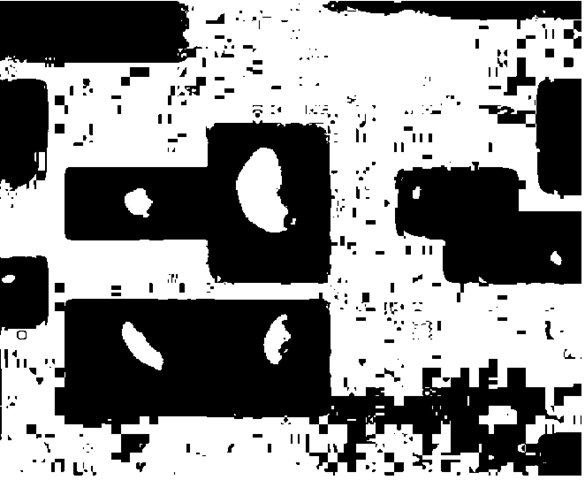
Figure 7. A selection of eight irregularly shaped satellites of Saturn. The leftmost satellite is Atlas (S17), the A-ring shepherd. The next pair (top to bottom) are the F-ring shepherds Pandora (S15) and Prometheus (S16); then follow the two coorbiting satellites Janus (S10) and Epimetheus (S11); then come the two Tethys Lagrangian satellites Calypso (S14) and Telesto (S13), and finally at the right is the Dione leading Lagrangian satellite Helene (S12) (NASA photomontage).
Some of the larger ones have a discernible number of craters on their surfaces. Most of them appear to be of icy compositions. Not much is known about the recently discovered satellites S/2000 S1-S12, except that they are relatively small, from 10-50 km in diameter, and are irregular satellites.
Titan
The largest moon of Saturn, Titan, has turned out to be one of the most interesting satellites in the solar system. With a diameter is 5150 km, it is one of the largest solid objects in the solar system, only slightly smaller than Ganymede of Jupiter, but considerably bigger than the planet Mercury, and easily dwarfs our most distant member, Pluto. When Titan was discovered by Huygens in 1655, no one could have foreseen that it held so many surprises. For centuries, people thought of it as just another moon whose position, orbit, brightness, transits across Saturn, etc. needed to be duly observed and recorded. It was not until modern instrumentation was employed that Titan revealed its unusual nature. Selected physical parameters for Titan are listed in Table 6.
Using infrared spectroscopy, G.P. Kuiper in 1943 detected deep methane absorptions, similar in strength to those of other major planets. This was quite astonishing for a satellite. Further observations, in the 1970s, of stronger methane bands farther in the infrared, combined with careful laboratory comparison spectra, led to the conclusion that the amount of methane on Titan was of the order of 20% of the total Earth’s atmosphere; a very substantial atmosphere twenty times larger than the atmosphere on Mars. More advances in infrared instrumentation in the 10 to 20 mm region revealed the presence of ethane (C2H6), ethylene (C2H4), and acetylene (C2H2).
Table 6. Selected Physical Parameters for Titan
| Diameter | 5150 km |
| Mass | 1.35 x 1026g = 0.022me |
| Density | 1.88 |
| Surface gravity | 135 cms ” 2 |
| Temperature | |
| Surface | 94 K |
| Effective | 86 K |
| Tropopause(42 km, 128 mb) | 71K |
| Pressure surface | 1.50atm |
| Ratio rock/ice, by mass | 52/48 |
| Hydrogen (H) loss rate | 5 x 1027 atoms/s |
Ultraviolet data showed that the atmosphere of Titan must be quite hazy and filled with aerosols (small smog-like particles) that scatter the incoming radiation. There were suggestions that Titan’s atmosphere might be more substantial requiring the additional presence of spectroscopically nondetectable gases such as N2, Ne and Ar. From the limited amount of ground-based data, it was not possible to separate the effects of scattering from those of a denser atmosphere and a determination of the correct amount of CH4 in a vertical column of Saturn’s atmosphere remains elusive. It was clear, however, that Titan’s atmosphere exhibited a most interesting character.
The Voyager 1 spacecraft was therefore, targeted to pass very close to Titan, within 4000 km of its cloud tops. The data acquired were both disappointing and fascinating. Despite the excellent resolution of Voyager’s cameras, the hazy atmosphere prevented any glimpse of the surface, a surface which many investigators believe could be one of the most unusual and spectacular in our solar system. The hazy atmosphere was so pervasive and uniform that it took special image processing techniques to bring out a very faint banded structure and a small brightness difference between the Southern and Northern Hemispheres. Such an image is shown in Fig. 8. Pictures of the limb of the satellite proved more successful and showed several haze layers; the highest was 700 km above the surface. An image of this haze is presented in Fig. 9. (On Earth, the clouds and haze rarely reach above about 12 km.)
On the other hand, the atmospheric data returned were exceedingly interesting and fascinating. Three instruments provided the most important data. The ultraviolet spectra showed definite evidence of N2, the radio occultation experiment provided the atmospheric temperature profile and the surface pressure, and the infrared instrument discovered a whole host of new organic molecules, as well as temperature data and information on the atmospheric structure. In fact, one might say that the capabilities of the infrared instruments were as well matched to the investigation of Titan’s atmosphere, as might be hoped. The basic parameters of Titan’s physical properties and its atmospheric structure and composition are given in Tables 6 and 7.
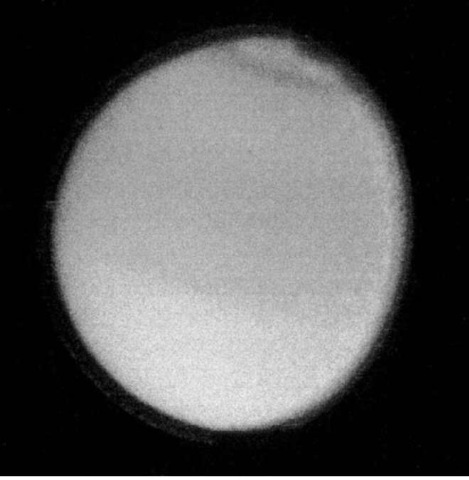
Figure 8. Voyager 2 image of Titan showing the thick, reddish cloud layer that obscures any surface features. A faint dark band is visible near the North Pole and the Southern Hemisphere is slightly ligher (NASA picture).
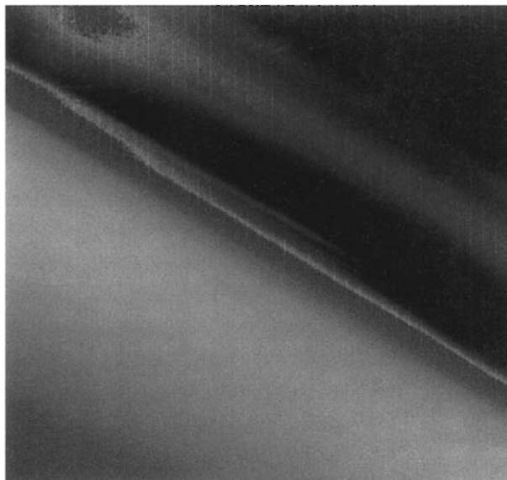
Figure 9. Voyager 1 picture of Titan’s limb showing the extensive high altitude haze extending to 700 km. The colors are false and are chosen to bring out the details of the haze structure (NASA picture).
The Voyager experiments found that CH4 is indeed a lesser constituent of Titan’s atmosphere, estimated at roughly 4% with a possible range of 2-10%. Thus, the exact amount of CH4 column abundance, although much better confined, is still not precisely determined. The major constituent of Titan’s atmosphere is molecular nitrogen (N2), just as on Earth. The surface pressure on Titan is 1.5 atm., and the surface temperature is 94 K. Although this surface pressure is only slightly greater than that of Earth, the amount of Titan’s atmosphere in numbers of molecules is actually 11 times greater. Because of Titan’s lower surface gravity (about seven times less than that of Earth), a greater amount of atmosphere is needed to provide the same surface pressure. The lower surface pressure also makes Titan’s atmosphere very much more extended than that of Earth. Its tropopause is at 42 km, whereas for Earth, it is around 10-12 km. Titan’s atmosphere from the surface to the visible cloud tops, near 1 mb pressure extends a full 200 km. This makes the visible pressure extends a full 200 km. This makes the visible disk seen in a telescope considerably larger than the solid surface.
The reason for Titan’s diverse composition can be found in the extraordinary photochemistry of its atmosphere. At high altitudes, methane is dissociated by the energy of solar ultraviolet radiation and forms free radicals such as CH2, CH3, and atomic hydrogen. The very reactive radicals form more complex hydrocarbon molecules such as ethane (C2H6), propane (C3H8), ethylene (C2H4), and acetylene (C2H2). The set of reactions that forms these molecules is rather complex. It includes creating and destroying radicals, vertical and horizontal transport in Titan’s atmosphere, and collisions with the abundant constituents of Titan’s atmosphere. A simplified set of reactions that produces acetylene and ethane using solar or photon energy, n being the frequency of radiation, and h Planck’s constant, is illustrated below.
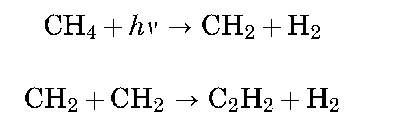
Table 7. Gases Observed in Titan’s Atmosphere
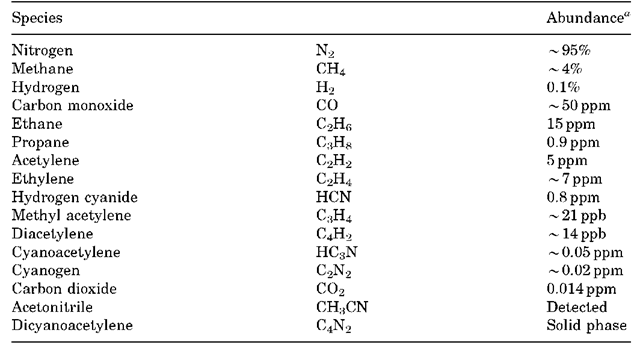
The acetylene produced can now form reactions that make ethane:
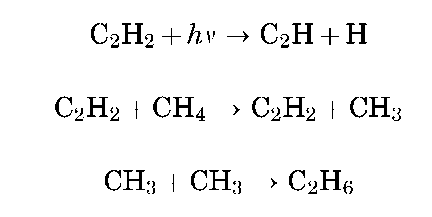
Because of the relatively low surface gravity of Titan, atomic and molecular hydrogen escape. Thus these reactions are not reversible, and Titan loses hydrogen steadily at a rate of roughly 5 x 1027 atoms/s. This loss of hydrogen and its replenishment by photochemical means results in an equilibrium concentration of 0.2% H2 in Titan’s atmosphere. Note that the photochemistry described is unique to Titan. It does not occur on Saturn because that planet has a huge reservoir of H2 which is held tightly by its very much larger gravity field.
The molecules produced include nitriles which are organic molecules that contain nitrogen. Additionally, oxygen-bearing molecules have been observed. The nitriles are formed by dissociation of N2 which has a very strong bond and is hard to break, so that it requires very energetic short wavelength UV radiation or electron impact dissociation high in Titan’s atmosphere. Chief among the nitriles are hydrogen cyanide, HCN and cyanogen (C2N2). The oxygen-bearing molecules are believed to come from impacts by comets, that contain ~ 50% water and can thus supply oxygen.
The photochemistry of Titan has been verified both by theoretical calculations and laboratory simulations. Essentially all of the molecules observed in Titan s atmosphere have been produced in roughly the proper abundance, using laboratory simulation experiments. The net result of Titan s photochemistry is the loss of hydrogen and the production of heavier and more complex hydrogen-deficient organic molecules. As of the year 2000, 13 complex molecules were identified in Titan’s atmosphere, as listed in Table 7. Laboratory simulations have produced an additional 20 or so complex hydrocarbon molecules that should be present in sufficient abundance that they should be detectable by some of the instruments of the Cassini spacecraft Huygens probe.
There are further important consequences of Titan’s photochemistry, which explain the satellite’s pervasive haze layer. Complex organic molecules can connect to form long-chain polymers. These polymer chains can apparently grow to complexes containing several hundred molecules and reach a size of the order of 0.1 mm radius. These small particles in turn form irregular aggregates of 0.40.5 mm radius, and these aggregates form aerosol particles in Titan’s atmosphere. Their approximate size has been determined by their light scattering properties from the ultraviolet to the infrared.
The present consensus holds that the haze in Titan’s atmosphere does not extend to the surface, but that the atmosphere below the tropopause at a height of about 70 km is clear. Calculations further show that it would take 50 years for the 0.5-mm smog particles to fall to the surface, so that some mechanism must exist to clear the atmosphere of this haze, very possibly condensation and precipitation of methane rain.
Whatever the mechanism, a large amount of organic material, be it aerosol particles or condensible gaseous species such as ethane, must have accumulated for possibly billions of years, and it still accumulates on Titan’s surface. What the surface of Titan looks like, is therefore, an extremely tantalizing and an intriguing question. Glimpses of Titan’s surface have been obtained by imaging in regions of minimum CH4 absorption (so-called windows in the CH4 spectra) using the Hubble space telescope. These images reveal continent-sized albedo variations, but more detailed conclusions cannot be drawn. There is speculation about liquid methane lakes or oceans (a continuous source of methane in the atmosphere is required to replenish the methane that is being destroyed by photochemistry) or oceans several hundred meters to kilometers deep that contain a mixture of ethane, methane, and nitrogen, or possibly there is only dry land, and mechanisms that reprocess the organic material on the surface have not presently been considered.
Titan is an object in our solar system, which despite spacecraft visits, still has a large number of extremely interesting unanswered questions. For this reason, the Cassini mission decided to send a special probe called Huygens into Titan’s atmosphere, rather than the atmosphere of Saturn. It is hoped that this probe will answer the many questions about Titan’s unusual character.
One of the big mysteries of our Earth is, of course, how life began. A number of models of early Earth’s atmosphere postulate an extensive primordial atmosphere made up of H2,CH4,NH3,N2 etc. similar to the major planets. Through interactions with an intense solar wind, the Earth’s hydrogen was soon lost and left behind an atmosphere similar to that on Titan. The process of photochemistry could then produce the same suite of complex organic molecules that we see on Titan. Among these molecules, nitriles are the most important, because such molecules as hydrogen cyanide (HCN), cyanogen (C2N2), and cyanoacetylene (HC3N) play a crucial role in forming amino acids which are believed, to be the precursors to simple cell formation. Once life begins, photosynthesis produces oxygen. In a sense, Earth has an atmosphere very similar to that of Titan, in which the main constituent is N2. The major differences lie in the second major constituent, which on Titan is the reducing gas CH4, whereas on Earth it is the oxidizing molecule O2. Some of the O2 on Earth is produced by photodissociation of H2O, but the majority comes from plant photosynthesis. This process started after life began on Earth. On Earth, the surface temperature is, of course, much higher than on Titan, allowing reactions that would not occur on this satellite. Perhaps if the temperature were 50-100 degrees higher on Titan, life could form on this satellite also. In any case, the satellite allows us to study the type of chemical reactions and photochemistry that is analogous to the prebiotic processes that were at work on primitive Earth.
